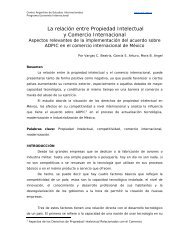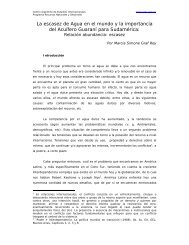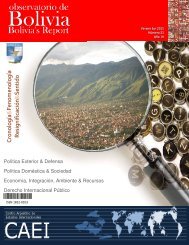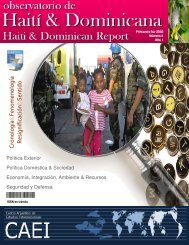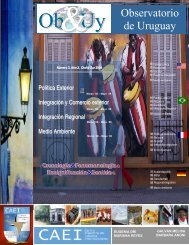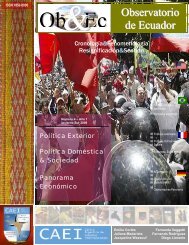Brazil's Defense Industry: The Emerging Transformational ... - CAEI
Brazil's Defense Industry: The Emerging Transformational ... - CAEI
Brazil's Defense Industry: The Emerging Transformational ... - CAEI
You also want an ePaper? Increase the reach of your titles
YUMPU automatically turns print PDFs into web optimized ePapers that Google loves.
DEVELOPMENTAL SETTINGS: CHALLENGES OF THINKING BIG<br />
<strong>The</strong> first decade of the 21st century demonstrated Brazil´s visible and aggressive commitment to<br />
progress. This is demonstrated by improved government and economic performance. Brazil´s<br />
economy is back on top after weathering the global slowdown.<br />
Brazil’s goals are sustained by the interdependency assumptions. Robert Art (2003:20) 7 explains this<br />
concept “as the size and importance of the stake that a state has (or believe it has) in economic<br />
intercourse with other states – in trading with them and in seeing capital and technology flowing<br />
easily among them. <strong>The</strong> higher the perceived interdependence, the larger a state’s presumed stake<br />
in the economic well-being of the countries with which it most interacts economically. At high levels of<br />
interdependency, all other things being equal, a state will want others to prosper because of the belief<br />
that this adds to its own prosperity.”<br />
According to <strong>The</strong> Economist, in 25 years, the BRIC countries will be even more important to the rest<br />
of the growing world. Between 2011 and 2014, Brazil plans to spend almost US$ 530 billion on<br />
infrastructure. In addition, Brazil’s oil company Petrobras, indicates investments of around US$ 108<br />
billion by 2014. 8<br />
With a GDP of US$ 2,052 billion, and a large projected growth rate, trend foresight of Brazil’s<br />
sustained development are based on five linked assumptions: (1) regional political stability and rates<br />
of market sharing; (2) global energy demands and Brazil’s potential self-sufficiency; (3) fiscal<br />
responsibility and inflation target regime; (4) floating exchange rate and stability of protein production<br />
(food supply); and (5) critical infrastructure augmentation and sustainment of technology pattern<br />
replication.<br />
<strong>The</strong>se assumptions are driving the perception that, in order to meet current and future developmental<br />
challenges in the support of a 4.5 percent settled GDP growth and increasing international<br />
prominence, Brazil needs a Security and <strong>Defense</strong> Complex (SDC) that enables it to be tactically<br />
flexible, operationally resilient, strategically adaptive, and politically accountable.<br />
Current operations of Brazil’s SDC span a broad range of relatively independent government<br />
institutions, agencies, industries, research centers, universities, activities and commands. In order to<br />
meet and overcome the challenges of national development, the Government embarked on a path to<br />
modernize the SDC and to (re)design the force.<br />
As a result, the Ministry of <strong>Defense</strong> developed a capacity building effort centered in five major<br />
programs: (1) area control and power projection (nuclear submarines and a new northern fleet with<br />
amphibious capability); (2) air defense and strategic mobility (fighters, missiles, helicopters,<br />
transporters and tankers); (3) borders control and geostrategic dominance (advanced light main<br />
battle tank, troop transport, unconventional tactical weaponry suite); (4) cybernetics (satellite, global<br />
7 Art, Robert J. A Grand Strategy for America. Ithaca, US: Cornell University, 2003.<br />
8 Washington Post, April 18, 2011.<br />
5<br />
Todos los derechos reservados. - Pág. 5





